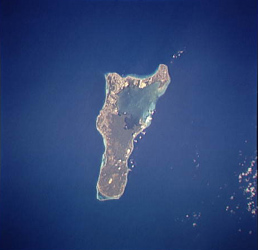Grand Cayman Island is a popular spot for divers. The small Caribbean island offers clear waters, and it’s surrounded on all sides by sheer walls — rock faces that drop hundreds of feet.
 Grand Cayman island. Credit: NASA
Grand Cayman island. Credit: NASAThe walls are so dramatic because the island is actually the peak of an underwater mountain range — the Cayman Ridge. The ridge formed where two plates of Earth’s crust sideswipe each other. The North American Plate is moving westward, while the Caribbean Plate is moving eastward. The intersection of the two plates pushes rock upward, building the Cayman Ridge. The intersection also created the Cayman Trough on the south side of the ridge — a canyon that reaches depths of almost five miles.
There are three islands in the Cayman chain, which is south of Cuba. Grand Cayman is the largest — a bit more than 20 miles long and eight miles wide. Coral reefs ring the island, creating a large lagoon.
The island is quite flat, and it’s made of porous limestone, so no streams or rivers flow across it. That means no dirt or debris washes off the land to cloud the surrounding waters.
The steepest of Grand Cayman’s walls begins plunging into the ocean depths just a short distance from shore. It drops to a depth of about 800 feet before the slope begins to level off a little. Giant boulders that tumbled down the slope litter the wall’s base. And life is abundant from top to bottom — a hodge-podge of coral, rays, sponges, sharks, and many other creatures — all living along the steep flank of an underwater mountain.

